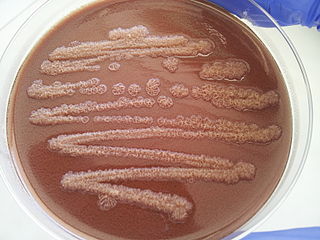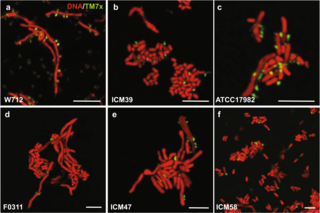Related Research Articles

Rhodococcus is a genus of aerobic, nonsporulating, nonmotile Gram-positive bacteria closely related to Mycobacterium and Corynebacterium. While a few species are pathogenic, most are benign, and have been found to thrive in a broad range of environments, including soil, water, and eukaryotic cells. Some species have large genomes, including the 9.7 megabasepair genome of Rhodococcus sp. RHA1.
Pseudomonas citronellolis is a Gram-negative, bacillus bacterium that is used to study the mechanisms of pyruvate carboxylase. It was first isolated from forest soil, under pine trees, in northern Virginia, United States.

Pseudomonas stutzeri is a Gram-negative soil bacterium that is motile, has a single polar flagellum, and is classified as bacillus, or rod-shaped. While this bacterium was first isolated from human spinal fluid, it has since been found in many different environments due to its various characteristics and metabolic capabilities. P. stutzeri is an opportunistic pathogen in clinical settings, although infections are rare. Based on 16S rRNA analysis, this bacterium has been placed in the P. stutzeri group, to which it lends its name.

Shewanella is the sole genus included in the marine bacteria family Shewanellaceae. Some species within it were formerly classed as Alteromonas. Shewanella consists of facultatively anaerobic Gram-negative rods, most of which are found in extreme aquatic habitats where the temperature is very low and the pressure is very high. Shewanella bacteria are a normal component of the surface flora of fish and are implicated in fish spoilage. Shewanella chilikensis, a species of the genus Shewanella commonly found in the marine sponges of Saint Martin's Island of the Bay of Bengal, Bangladesh.

Shewanella oneidensis is a bacterium notable for its ability to reduce metal ions and live in environments with or without oxygen. This proteobacterium was first isolated from Lake Oneida, NY in 1988, hence its name.

Streptomyces griseus is a species of bacteria in the genus Streptomyces commonly found in soil. A few strains have been also reported from deep-sea sediments. It is a Gram-positive bacterium with high GC content. Along with most other streptomycetes, S. griseus strains are well known producers of antibiotics and other such commercially significant secondary metabolites. These strains are known to be producers of 32 different structural types of bioactive compounds. Streptomycin, the first antibiotic ever reported from a bacterium, comes from strains of S. griseus. Recently, the whole genome sequence of one of its strains had been completed.

Saccharibacteria, formerly known as TM7, is a major bacterial lineage. It was discovered through 16S rRNA sequencing.
Streptomyces acidiscabies is a streptomycete bacterium species, causing a scab disease of potatoes. Its type strain is RL-110.
Clostridium autoethanogenum is an anaerobic bacterium that produces ethanol from carbon monoxide, in so-called syngas fermentation, being one of the few known microorganisms to do so. It is gram-positive, spore-forming, rod-like, motile, and was first isolated from rabbit feces. Its type strain is strain JA1-1. Its genome has been sequenced.
Rhodococcus opacus is a bacterium species in the genus Rhodococcus. It is moderately chemolithotrophic. Its genome has been sequenced.R. opacus possesses extensive catabolic pathways for both sugars and aromatics and can tolerate inhibitory compounds found in depolymerized biomass
Deinococcus marmoris is a Gram-positive bacterium isolated from Antarctica. As a species of the genus Deinococcus, the bacterium is UV-tolerant and able to withstand low temperatures.
Shewanella woodyi is an exclusively respiratory luminous bacterium. It is non-fermentative, with type strain ATCC 51908.
Clostridium straminisolvens is a moderately thermophilic, aerotolerant and cellulolytic bacterium. It is non-motile, spore-forming, straight or slightly curved rod, with type strain CSK1T. Its genome has been sequenced.
Methylopila jiangsuensis is a Gram-negative, aerobic, facultatively methanotrophic and non-spore-forming bacterium species from the genus Methylopila which has been isolated from activated sludge from a waste water treatment plant from Yangzhou in the Jiangsu Province in China.
Microbacterium barkeri is a bacterium from the genus of Microbacterium which has been isolated from domestic sewage and from smear from a cheeses. Microbacterium barkeri has the ability to degrade polyvinyl alcohol.
Tsukamurella pseudospumae is a bacterium from the genus of Tsukamurella which has been isolated from activated sludge foam from an activated sludge treatment plant in England.
Xenophilus azovorans is a bacterium from the genus Xenophilus which has been isolated from soil in Switzerland.
Caenibius tardaugens is an oestradiol-degrading bacterium from the family Hyphomicrobiaceae which has been isolated from activated sludge from a sewage treatment plant in Japan.
Komagataeibacter xylinus is a species of bacteria best known for its ability to produce cellulose, specifically bacterial cellulose.
Sulfobacillus thermosulfidooxidans is a species of bacteria of the genus Sulfobacillus. It is an acidophilic, mixotrophic, moderately thermophilic, Gram-positive, sporulating facultative anaerobe. As its name suggests, it is capable of oxidizing sulfur.
References
- ↑ Xu, M. (2005). "Shewanella decolorationis sp. nov., a dye-decolorizing bacterium isolated from activated sludge of a waste-water treatment plant". International Journal of Systematic and Evolutionary Microbiology. 55 (1): 363–368. doi: 10.1099/ijs.0.63157-0 . ISSN 1466-5026. PMID 15653901.
- ↑ Xu, M.; Fang, Y.; Liu, J.; Chen, X.; Sun, G.; Guo, J.; Hua, Z.; Tu, Q.; Wu, L.; Zhou, J.; Liu, X. (2013). "Draft Genome Sequence of Shewanella decolorationis S12, a Dye-Degrading Bacterium Isolated from a Wastewater Treatment Plant". Genome Announcements. 1 (6): e00993-13–e00993-13. doi:10.1128/genomeA.00993-13. ISSN 2169-8287. PMC 3853061 . PMID 24309738.